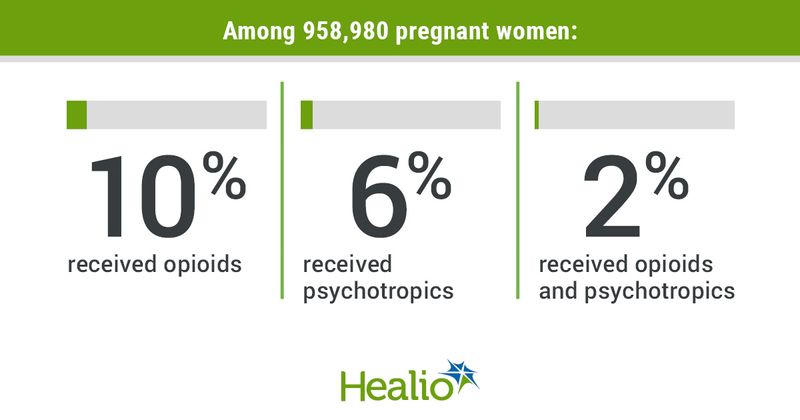Pregnant women ‘frequently’ coprescribed opioids, psychotropics
Pregnant women were “frequently” coprescribed opioids and psychotropic medications, researchers of a cross-sectional study wrote. These prescriptions sometimes led to antepartum hospitalization, they added.
“While we know that pregnant women with opioid use and co-occurring mental health conditions are at risk for adverse outcomes, less is understood about prescribing patterns of opioids and psychotropics among pregnant women,” Marcela C. Smid, MD, MA, MS, an assistant professor in the division of maternal-fetal medicine at the University of Utah, told Healio Primary Care.

“With increased attention to opioid prescribing over the past decade and the importance of addressing maternal mental health, we were interested in prescribing patterns and changes over time in this population,” she continued.
The researchers analyzed United States commercial insurance beneficiary data for 958,980 pregnant women across all 50 states from 2001 to 2015. The findings, published in Annals of Internal Medicine, showed that:
- 10% of pregnant women received opioids only;
- 6% received psychotropics only; and
- 2% simultaneously received opioids and psychotropics.
Opioid prescriptions were higher among those prescribed psychotropics compared with those who were not (26.5% vs. 10.7%), according to the researchers. From 2000 to 2015, they reported that:
- The percentage of pregnant women who received morphine milligram equivalents (MME) of 50 or greater daily dropped from 29.6% to 17.3% among those with coprescriptions and from 22.8% to 18.5% among those without coprescriptions.
- The percentage of women who obtained MME of 90 or greater daily declined from 15% to 4.7% among those with coprescriptions and 11.5% to 4.2% among those without coprescriptions.
- Overall, psychotropic prescriptions rose from 4.4% to 7.6%.
- The percentage of women who received opioid prescriptions without a concurrent prescription of psychotropics decreased from 11.9% to 8.4%.
- The percentage of those who received opioids with coprescription declined from 28.1% to 22%.
Smid and colleagues also reported that women who were only prescribed opioids were more likely to have an antepartum hospitalization vs. those with neither prescription, as were women with coprescription vs. those prescribed psychotropics only. Compared with those only prescribed opioids, women with coprescriptions were more likely to exceed 90 MME daily and be prescribed two or more opioid agents for 30 days or longer. The number of opioids, along with the duration they were taken, increased with benzodiazepine and gabapentin coprescription.

Even though researchers could not determine the appropriateness of any prescriptions or occurrence of overdose events, the analysis still yielded useful information, Smid said.
“These findings help us to understand that there are some women who received prescription medications that may place them at high risk of antepartum hospitalization, perinatal complications and ultimately death,” she said.
Smid said that future research should examine how maternal opioid use and mental health contributes to maternal morbidity and mortality. She also called for strategies to help pregnant women with their medical and mental health needs while avoiding serious complications.

